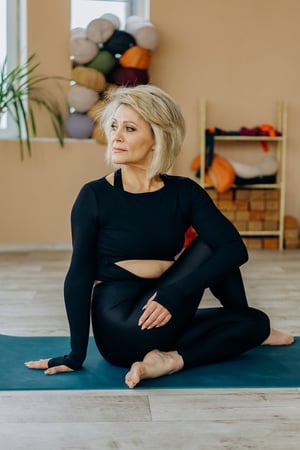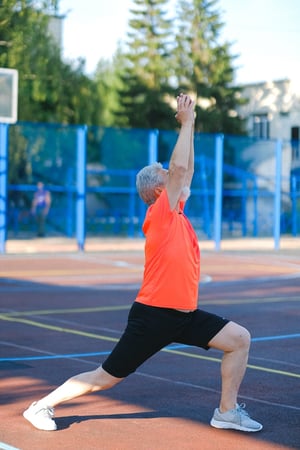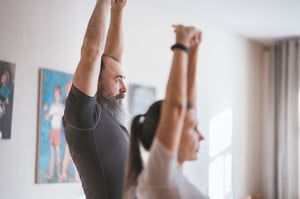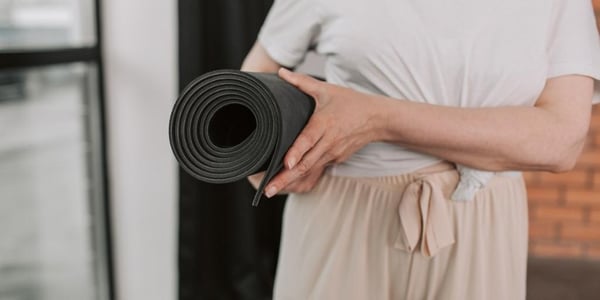Pilates has become increasingly popular among adults of all ages, and for good reason. This...
How (and Why) To Increase Flexibility at Any Age
As we age, the body undergoes many changes, including stiffening joints and decreasing muscle mass. To maintain mobility, it is crucial to find ways to improve the flexibility of joints and muscles. By increasing flexibility, muscle mass and balance improve, which lowers the risk of falls and injuries. In addition, when a fall does occur, the body is better able to prepare for the impact, recover, and result in fewer injuries.
Why it is Important to Increase Flexibility
 Flexibility plays many vital roles in the way the body moves and the health of muscles and joints. By practicing stretches, yoga, and simple exercises, joint movement improves. This allows for greater freedom of movement and will slow the aging process and degradation of the ligaments and cartilage, which will reduce the likelihood of falling.
Flexibility plays many vital roles in the way the body moves and the health of muscles and joints. By practicing stretches, yoga, and simple exercises, joint movement improves. This allows for greater freedom of movement and will slow the aging process and degradation of the ligaments and cartilage, which will reduce the likelihood of falling.
These activities, while improving flexibility, will also improve strength and maintain mass within the muscles so that one can continue walking later in life. Thus, it is possible to delay or limit the need for a wheelchair and improve the quality of life. Improvement in circulation also results from these activities. It will help keep the body healthy. The cells will receive the oxygen and nutrients needed to maintain the muscles and protect the joints.
Flexibility also affects the sense of balance, reducing falls, improving movement, and improving quality of life. As balance begins to worsen, people are more prone to bump into things, become dizzy, or find it hard to focus, and they are more likely to fall. As a person falls, their body will try and slow the fall and find a way to land that will cause the least harm.
Simple Ways to Improve Flexibility
As people age, their bodies develop new limitations each year. To prevent this and even reverse the beginning stages, complete tasks and activities that improve flexibility daily. Activities that are good for flexibility include yoga, simple daily stretches, balance, and slow and intentional movements.
 There are many options for yoga at any age, and they can be completed almost anywhere. Chair Yoga is an easy way for seniors or aging bodies to keep moving and improve the flexibility of the joints without adding pressure to them by remaining standing. Seated poses do not increase wear or tear on the joints and can help them stay healthy. These can be found either in a local class, with an instructor who will travel to any location and do a small class or individual session or through television or online videos. It is important to move slowly through each position and focus on the correct movements to avoid injury.
There are many options for yoga at any age, and they can be completed almost anywhere. Chair Yoga is an easy way for seniors or aging bodies to keep moving and improve the flexibility of the joints without adding pressure to them by remaining standing. Seated poses do not increase wear or tear on the joints and can help them stay healthy. These can be found either in a local class, with an instructor who will travel to any location and do a small class or individual session or through television or online videos. It is important to move slowly through each position and focus on the correct movements to avoid injury.
The benefits of yoga include improved circulation and cell repair, slowed signs of aging within the body, and increased mental focus and comprehension. The improved mental state achieved through yoga can also decrease depression, encouraging people to want to remain moving and keep doing the activities they love. An improved mental state can also benefit the body's physical health, balance, and flexibility.
Where there is no access to yoga, or it is not suitable, completing a set of simple stretches each morning will help improve flexibility and help maintain movement and circulation. These can be seated or in a standing position and adapted for each individual person. Stretches such as the following are all beneficial for the whole body and mind.:
- Raising your arms in front of the body, then moving them to the side
- Stretching arms above the head and then out to the side
- Or even gentle lunge-like movements that stretch the back of the legs
One of the more strenuous activities that will benefit balance and flexibility is to practice some balancing activities. These should be done in a supervised situation and with a chair or walker to hold. To do so:
- Stand comfortably facing a chair, walker, or another stable item with handles
- Practice standing on one foot for short periods of time
- Start by raising the other foot slightly off the ground and bending the knee
- Try to do so for a few seconds at a time
- With practice, gradually increase the time you stand on one leg
 These will help the body adjust to the alignment of standing with weight on one foot or the other. This movement and the slight adjustments will improve flexibility within the joints and alignment. Each of the muscles used will shift and tense in small ways that will not be enough to be painful but are enough to increase the movement. This will improve both balance and flexibility.
These will help the body adjust to the alignment of standing with weight on one foot or the other. This movement and the slight adjustments will improve flexibility within the joints and alignment. Each of the muscles used will shift and tense in small ways that will not be enough to be painful but are enough to increase the movement. This will improve both balance and flexibility. These activities should be completed focusing on feeling the movement through the body and how each muscle responds. This focus will also work as a type of meditation that improves brain functioning, memory, and concentration and decreases concerns such as depression or anxiety.
The body does begin to tense, slow, and even deteriorate as people age. Still, some activities can help slow this process and help maintain the balance and flexibility needed to stay active and healthy. Each of these will help improve blood circulation, focus, balance, and flexibility, all of which will decrease the likelihood of a fall and improve the quality of life of the individual. In addition, as flexibility improves, the body is able to move more freely, stability is improved, and if a fall does occur, the body will adapt to it in a way that will lower the likelihood of permanent injury. These are all important aspects in keeping an aging person safe and healthy and can be completed in just a few minutes each day or a few times each week.
Click here to learn more in our post, 3 Reasons to Stand and Stretch Right Now!
Then, get started with the 5 Best Daily Stretching Exercises to Try Now!






